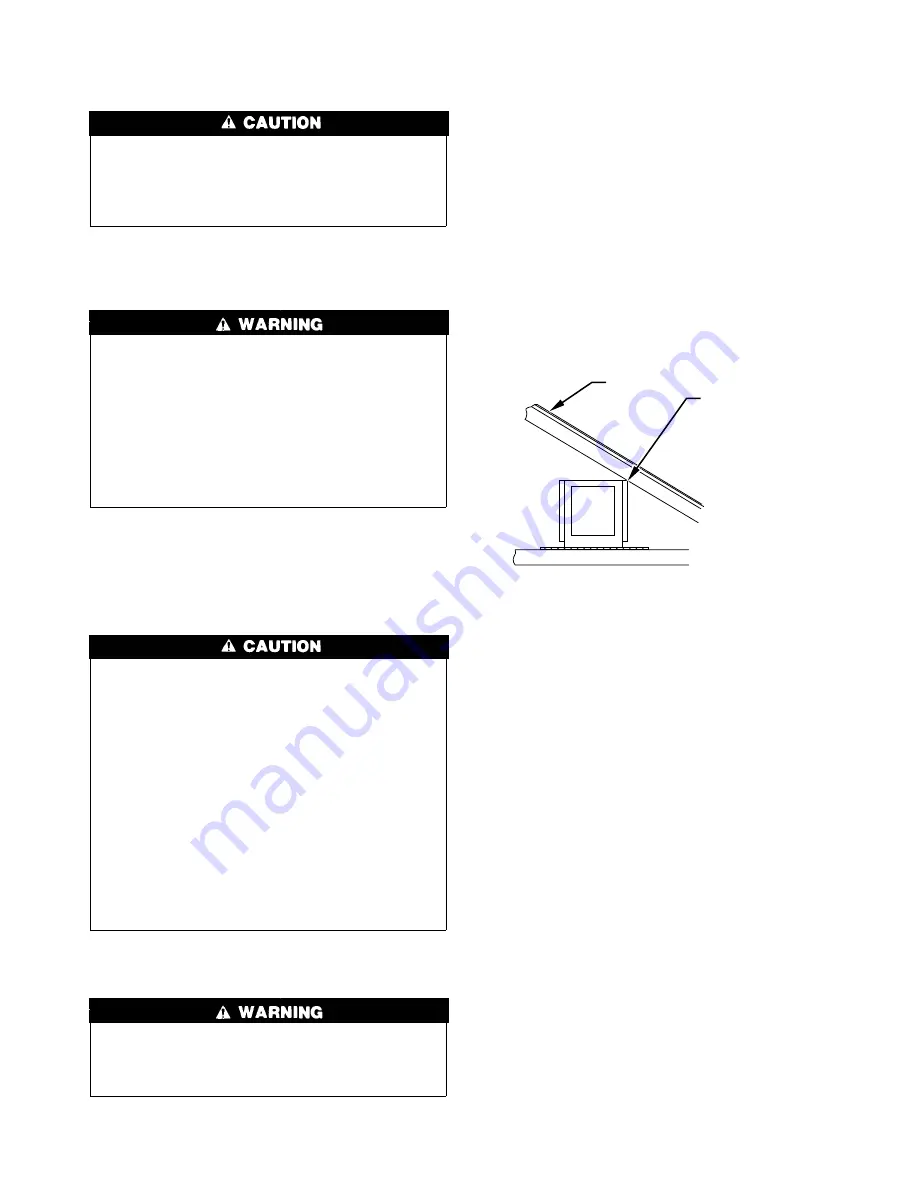
Canadian installations must be made in accordance with
CAN/CGA-B149 Installation Codes and authorities having juris-
diction.
Application of this furnace should be indoors with special
attention given to vent sizing and material, gas input rate, air
temperature rise, and unit sizing. Improper installation or
misapplication of the furnace can require excessive servicing
or cause premature component failure.
This furnace is designed for a minimum continuous return-air
temperature of 60°F db or intermittent operation down to 55°F db
such as when used with a night setback thermostat. Return-air
temperature must not exceed a maximum of 85°F db.
Improper installation, adjustment, alteration, service, mainte-
nance, or use can cause carbon monoxide poisoning, explo-
sion, fire, electrical shock, or other conditions which may
cause personal injury or property damage. Consult a qualified
installer, service agency, local gas supplier, your distributor,
or your branch for information or assistance. The qualified
installer or agency must use only factory-authorized and
listed kits or accessories when modifying this product. Failure
to follow this warning could result in electrical shock, fire,
personal injury, or death.
For accessory installation details, refer to the applicable installa-
tion literature.
NOTE:
Remove all shipping brackets and materials before oper-
ating furnace.
LOCATION
Step 1—General
Do not install furnace in a corrosive or contaminated atmo-
sphere. Make sure all combustion and circulating air require-
ments are followed, in addition to all local codes and
ordinances.
Do not use this furnace during construction when adhesives,
sealers, and/or new carpets are being installed. If the furnace
is required during construction, use clean outside air for
combustion and ventilation. Compounds of chlorine and
fluorine when burned with combustion air form acids which
cause corrosion of the heat exchangers and metal vent system.
Some of these compounds are found in paneling and dry wall
adhesives, paints, thinners, masonry cleaning materials, and
many other solvents commonly used in the construction
process.
Excessive exposure to contaminated combustion air will
result in safety and performance related problems.
This furnace may be located in an attic, basement, crawlspace,
alcove, or suspended from the ceiling of a utility room or
basement.
Do not install the furnace on its back or side. Safety control
operation will be adversely affected. Never connect return-air
ducts to the back of the furnace. Failure to follow this warning
could result in a fire, personal injury, or death.
When a furnace is installed so that the supply ducts carry air to
areas outside the space containing the furnace, return air must also
be handled by duct(s) sealed to furnace casing and terminating
outside the space containing furnace to ensure there will not be a
negative pressure condition within the equipment room or space.
This furnace must be located so electrical components are pro-
tected from water.
Locate furnace close to the chimney/vent and as near the center of
air distribution system as possible. The furnace should not be
connected to an operating chimney that also serves a solid fuel
burning appliance.
Provide ample space for servicing and cleaning. Always comply
with the minimum fire protection clearances shown on the unit
rating plate and in Table 1. A clearance of at least 30 in. should be
provided at front of unit for servicing.
Locate furnace where available electrical and gas supplies meet the
specifications on furnace rating plate.
Line contact is only permissible between lines formed by the
intersection of furnace top and front and back sides and building
joists, studs, or framing. (See Fig. 2.)
For attic installations, the passageway and servicing area adjacent
to furnace should be floored.
If furnace is to be installed in a crawlspace, consult local codes.
Use of a concrete pad 1 to 2 in. thick is recommended.
Step 2—Furnace Location Relative to Cooling
Equipment
The cooling coil must be installed parallel with or on the
downstream side of the furnace to avoid condensation in the heat
exchanger. When installed parallel with a furnace, dampers or
other means used to control the flow of air must prevent chilled air
from entering the furnace. If the dampers are manually operated,
they must be equipped with a means to prevent operation of either
unit unless the damper is in the full-heat or full-cool position.
Step 3—Hazardous Locations
When furnace is installed in a residential garage, it must be
installed so that the burners and ignition source are located a
minimum of 18 in. above the floor. Furnace must be located or
protected to avoid physical damage by vehicles.
When furnace is installed in a public garage, airplane hangar, or
another building having a hazardous atmosphere, the unit must be
installed in accordance with the requirements of the National Fire
Protection Association, Inc.
Fig. 2—Attic Installation Showing Point Contact
A96069
ROOF
LINE CONTACT ONLY
PERMISSIBLE BETWEEN
TOP CORNERS OF
FURNACE AND BUILDING
JOISTS, STUDS, OR
FRAMING.
KEEP ALL INSULATING MATERIAL
CLEAR OF FURNACE. INSULATING
MATERIAL MAY BE COMBUSTIBLE.
3


















